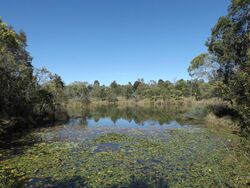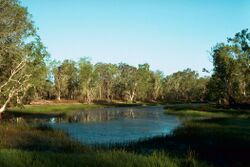Earth:Billabong
Billabong (/ˈbɪləbɒŋ/ BIL-ə-bong) is an Australia term for an oxbow lake, an isolated crescentic pond left behind after a river loop is cut off when the river channel changes course.[1] Billabongs are usually formed when the path of a creek or river changes due to bank erosion, leaving the former channel deprived of further inflow and becoming a dead-end gully holding only residual water that has not yet drained or evaporated. As a result of the arid climate of many parts of Australia, these "dead rivers" often fill with water seasonally but can be dry for a greater part of the year.[2]
Billabongs are significant because they do not have outflow and can hold water longer than sections of rivers especially during drier season, thus serving important ecological functions as waterholes and habitats for semiaquatic animals such as frogs. In the older days, these were important landmarks for people to identify and many billabongs were namesaked by the local areas.[3][4][5]
Etymology
The etymology of the word billabong is disputed. The word is most likely derived from the Wiradjuri term bilabaŋ, which means "a watercourse that runs only after rain". It is derived from bila, meaning "river",[6] It may have been combined with bong or bung, meaning "dead".[7][8] One source, however, claims that the term is of Scottish Gaelic origin.[9]
References in Australian culture
In literature
Under the shade of a coolibah tree,
And he sang as he watched and waited till his billy boiled,
Who'll come a'waltzing Matilda with me
Banjo Paterson, Waltzing Matilda
- Banjo Paterson's popular song "Waltzing Matilda" is set beside a billabong.
- Mary Grant Bruce wrote a series of books, known as The Billabong Series, depicting the adventures of the Linton family, who live at Billabong station from around 1911[10] until the late 1920s.[11][12]
In art
Both Aboriginal Australians and European artists use billabongs as subject matter in painting. For example, Aboriginal painter Tjyllyungoo (Lance Chad) has a watercolour entitled Trees at a billabong.[13]
American avant-garde filmmaker Will Hindle produced a short film titled Billabong in 1969.
In commerce
Billabong is the name of an Australian brand of sportswear for surf, skateboard, and snowboard.
See also
References
- ↑ "Rivers Continuing in Time". Burarra Gathering. Wurdeja, Ji-malawa and Yilan Aboriginal Communities. 21 June 2006. http://burarra.questacon.edu.au/pages/billabong.html.
- ↑ USGS [Annotated Definitions of Selected Geomorphic Terms and Related Terms of Hydrology, Sedimentology, Soil Science, and Ecology], USGS Open File Report 2008-1217.
- ↑ Clarke, R. "Australianisms in 'Waltzing Matilda'", Xamax Consultancy Pty Ltd, 10 December 2003. Last accessed 23 February 2018.
- ↑ Ludowyk, F.. "Of Billy, Bong, Bung, & 'Billybong'". http://andc.anu.edu.au/pubs/ozwords/October_2004/Billy.html.
- ↑ "billabong", Merriam-Webster Dictionary Online. Accessed 23 February 2018.
- ↑ "billabong." The Macquarie Dictionary. South Yarra: The Macquarie Library Pty Ltd., 2005. Credo Reference. Web. 19 January 2012.
- ↑ A. P. Elkin (June 1967). "Review of Australian English: An Historical Study of the Vocabulary, 1788-1898 by W. S. Ramson". Oceania (Oceania Publications, University of Sydney) 37 (4): 318–319. doi:10.1002/j.1834-4461.1967.tb00924.x.
- ↑ "billabong". Dictionary.com. http://dictionary.reference.com/browse/billabong.
- ↑ Skilton, St J. (June 2004). "The Survey of Scottish Gaelic in Australia and New Zealand". p. 300. http://ethesis.unifr.ch/theses/downloads.php?file=SkiltonS.pdf. ""'Bill' = 'bile' = 'lip or mouth' and 'abong' is from 'abhainn' = 'river' with a parasitic 'G' added. A billabong probably has a mouth shape of sorts being at a bend in a river.""
- ↑ Bruce, Mary Grant. A Little Bushmaid.
- ↑ Bruce, Mary Grant. Billabong Adventurers.
- ↑ Pierce, Peter (2009). The Cambridge history of Australian literature. Cambridge, England; New York: Cambridge University Press. ISBN 978-0-521-88165-4.
- ↑ "Trees at a billabong". National Museum Australia. 2013. http://collectionsearch.nma.gov.au/object/145738.
External links
 |



